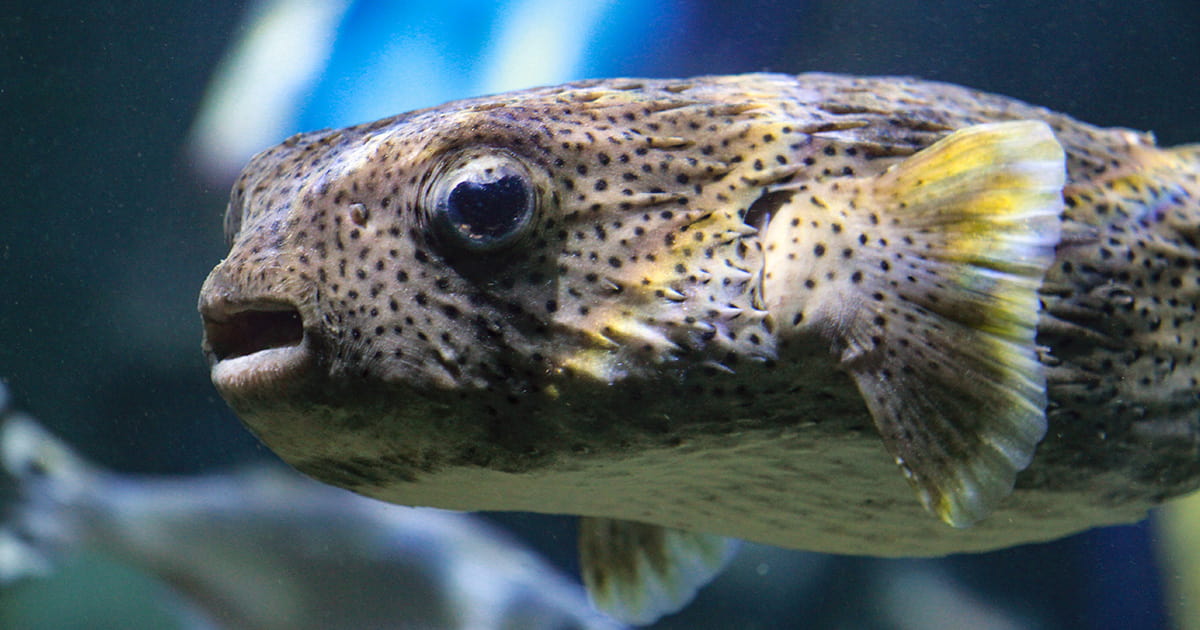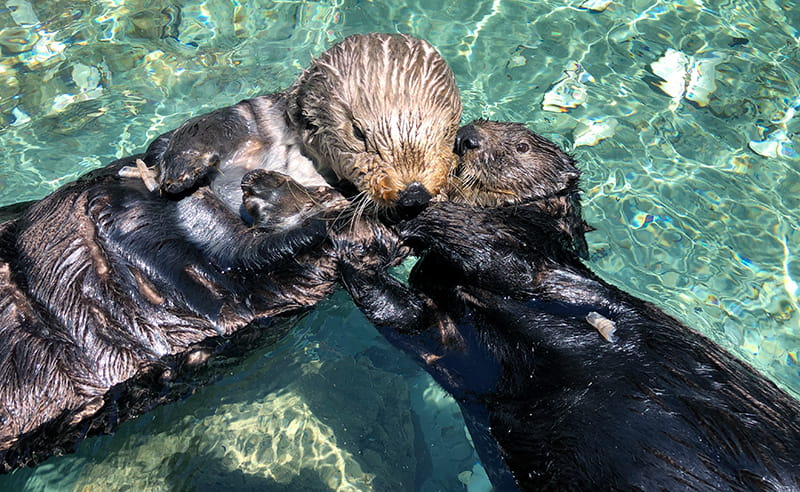With their bulbous bodies, large eyes and beak-like teeth, porcupinefish stand out from the crowd. But there’s more to these quirky fish than meets the eye. Test your ability to parse porcupinefish fact from “fishin’” by mousing over the boxes below!
With their bulbous bodies, large eyes and beak-like teeth, porcupinefish stand out from the crowd. But there’s more to these quirky fish than meets the eye. Test your ability to parse porcupinefish fact from “fishin’” by tapping the boxes below!

When a porcupinefish is threatened or provoked, it can puff itself up to twice its size
Fact!
Porcupinefish can inflate their bodies by swallowing water (or air), becoming rounder and doubling in size. This makes them appear larger, scaring off potential predators.
A porcupinefish gets its name from the round shape of a porcupine's body and its shy but curious nature
Fishin'
A porcupinefish is covered with sharp spines (up to 2 inches long) that lay flat against its body. When it puffs up, the spines stick out and become sharp spikes (like a porcupine)!
Porcupinefish is just another name for pufferfish
Fishin'
While the two fish are often collectively referred to as pufferfish or “puffers,” and many people use the names interchangeably, they are indeed distinct. Other pufferfish have soft spines that are unnoticeable in some species, but only the porcupinefish has sharp, protective spines.
A porcupine fish sometimes swims upside down
Fact!
When a porcupinefish puffs itself up, the modified buoyancy causes it to turn upside down, although its movement looks more like bobbing than swimming. When the danger has passed, a porcupinefish will deflate, turn right-side up and continue on its way.
Porcupinefish (and other pufferfish) are an exotic delicacy
Fact!
In many parts of the world, porcupinefish and puffers are served in high-end restaurants even though their internal organs contain a neurotoxin that’s 1,200 times stronger than cyanide. It takes a trained eye to prepare the fish correctly. In Japan, chefs are required to undergo rigorous training and testing before they can serve the potentially lethal fish. Despite these precautions, several dozen people worldwide are poisoned each year by eating the fish.
One way to protect porcupinefish—and all the animals in the ocean—is to skip your daily shower
Fact (kind of)!
Taking shorter showers, or showering less frequently, is one way to conserve water and reduce energy use, which benefits all the animals that live in the ocean. How does saving energy at home help the ocean? Reducing your energy use reduces your carbon footprint—which in turn reduces the carbon emissions that contribute to ocean acidification.
When a porcupinefish is threatened or provoked, it can puff itself up to twice its size
Fact!
Porcupinefish can inflate their bodies by swallowing water (or air), becoming rounder and doubling in size. This makes them appear larger, scaring off potential predators.
A porcupinefish gets its name from the round shape of a porcupine's body and its shy but curious nature
Fishin'
A porcupinefish is covered with sharp spines (up to 2 inches long) that lay flat against its body. When it puffs up, the spines stick out and become sharp spikes (like a porcupine)!
Porcupinefish is just another name for pufferfish
Fishin'
While the two fish are often collectively referred to as pufferfish, they are indeed distinct. Other pufferfish have soft spines that are unnoticeable in some species, but only the porcupinefish has sharp, protective spines.
A porcupine fish sometimes swims upside down
Fact!
When a porcupinefish puffs itself up, the modified buoyancy causes it to turn upside down. When the danger has passed, a porcupinefish will deflate, turn right-side up and continue on its way.
Porcupinefish (and other pufferfish) are an exotic delicacy
Fact!
In many parts of the world, porcupinefish and puffers are served in high-end restaurants even though their internal organs contain a neurotoxin that’s 1,200 times stronger than cyanide.
One way to protect porcupinefish—and all the animals in the ocean—is to skip your daily shower
Fact (kind of)!
Taking shorter showers, or showering less frequently, is one way to conserve water and reduce energy use, which benefits all the animals that live in the ocean.


